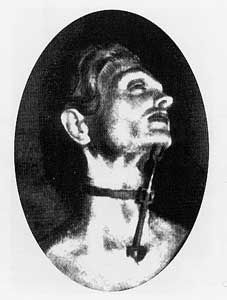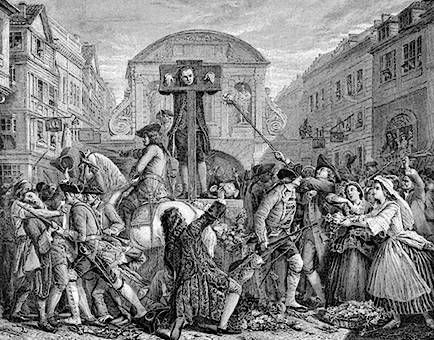Coffin Torture

.
The victim was placed inside the "coffin". Torturers were well-known for forcing overweight victims into the device, or even making the "coffin" slightly larger than normal to make the victims more uncomfortable.
The period of time a victim was to be kept inside the coffin was determined by his or her crime. Very serious crimes, such as blasphemy, were punished by death inside the coffin where the victim was to be kept inside under the sun with animals eating his or her flesh.
The coffin was sometimes placed in a public plaza so the local population would congregate around it and mock the unlucky victim. Sometimes death occurred because of the hatred towards the person as others often threw rocks and other objects to further increase the pain.
The Witch's chair

There are many variants of the chair. They all have one thing in common: spikes cover the back, arm-rests, seat, leg-rests and foot-rests. The number of spikes in one of these chairs ranges from 500 to 1,500.
To avoid movement, the victim's wrists were tied to the chair or, in one version, two bars pushed the arms against arm-rests for the spikes to penetrate the flesh even further. In some versions, there were holes under the chair's bottom where the torturer placed coal to cause severe burns while the victim still remained conscious.
This instrument's strength lies primarily in the psychological fear caused on the victims. It was a common practice to extract a confession by forcing the victim to watch someone else be tortured with this instrument.
The time of death greatly varied ranging from a few hours to a day or more. No spike penetrated any vital organ and the wound was closed by the spike itself which delayed blood loss greatly.
The heretics fork

The heretics fork was used in the Middles Ages mainly during the Spanish Inquisition
The instrument consists of two forks set against each other that penetrated the flesh under the chin in one end and the upper chest in the other. As usual, this instrument didn't harm any vital points; thus avoiding death and prolonging pain.
The victim's hands were tied behind his back to prevent any chance of escape. The Heretics Fork made speech and neck movement almost impossible and was used after a confession to avoid hearing the victim any further. As can be seen in the picture, a small collar supported the fork forcing the victim to hold his head erect.
Sometimes the victim was incarcerated and subject to this instrument as well. This instrument often harmed the neck of the victim, as well as potentially spreading an infection or disease.
Exposure
As its name implies, this method consists of exposing a victim to the elements. The victim could be buried up to his neck letting any animals, insects or other people kill him slowly.
In some towns there were chains, stocks or ropes used to quickly restrain someone. In many cases, the victim was simply left to die of hunger and thirst.
Due to its cost efficiency and cruelty, the exposure torture was very widespread in medieval Europe. The victim's remains often served as a warning to the population.
In many cases, the victim was sentenced to a short period of exposure, depending on the crime. However, death was frequent since they were completely defenseless.
The Pillory Torture

The pillory was used to publicly humiliate a victim. Even though it was meant as a mild form of punishment, the crowd sometimes made it lethal.
The pillory often served as a post for flagellation. When the victim was restrained with the device, he was completely defenseless and subject to the crowd.
In many cases the crowd threw harmless objects such as vegetables, but when the victim committed a serious offense they threw stones or other heavy objects. The crowd often humiliated the victim by cutting his hair, putting marks on his body and even mutilating some of his body parts.
The pillory didn't last more than a few hours, but it was sometimes carried on for days. The device was situated in either the marketplace or the plaza - where most villagers could see the victim's suffering. The army was also well-known for using the pillory as a means of punishment.
Happy Holidays!
The period of time a victim was to be kept inside the coffin was determined by his or her crime. Very serious crimes, such as blasphemy, were punished by death inside the coffin where the victim was to be kept inside under the sun with animals eating his or her flesh.
The coffin was sometimes placed in a public plaza so the local population would congregate around it and mock the unlucky victim. Sometimes death occurred because of the hatred towards the person as others often threw rocks and other objects to further increase the pain.
The Witch's chair

There are many variants of the chair. They all have one thing in common: spikes cover the back, arm-rests, seat, leg-rests and foot-rests. The number of spikes in one of these chairs ranges from 500 to 1,500.
To avoid movement, the victim's wrists were tied to the chair or, in one version, two bars pushed the arms against arm-rests for the spikes to penetrate the flesh even further. In some versions, there were holes under the chair's bottom where the torturer placed coal to cause severe burns while the victim still remained conscious.
This instrument's strength lies primarily in the psychological fear caused on the victims. It was a common practice to extract a confession by forcing the victim to watch someone else be tortured with this instrument.
The time of death greatly varied ranging from a few hours to a day or more. No spike penetrated any vital organ and the wound was closed by the spike itself which delayed blood loss greatly.
The heretics fork

The heretics fork was used in the Middles Ages mainly during the Spanish Inquisition
The instrument consists of two forks set against each other that penetrated the flesh under the chin in one end and the upper chest in the other. As usual, this instrument didn't harm any vital points; thus avoiding death and prolonging pain.
The victim's hands were tied behind his back to prevent any chance of escape. The Heretics Fork made speech and neck movement almost impossible and was used after a confession to avoid hearing the victim any further. As can be seen in the picture, a small collar supported the fork forcing the victim to hold his head erect.
Sometimes the victim was incarcerated and subject to this instrument as well. This instrument often harmed the neck of the victim, as well as potentially spreading an infection or disease.
Exposure
As its name implies, this method consists of exposing a victim to the elements. The victim could be buried up to his neck letting any animals, insects or other people kill him slowly.
In some towns there were chains, stocks or ropes used to quickly restrain someone. In many cases, the victim was simply left to die of hunger and thirst.
Due to its cost efficiency and cruelty, the exposure torture was very widespread in medieval Europe. The victim's remains often served as a warning to the population.
In many cases, the victim was sentenced to a short period of exposure, depending on the crime. However, death was frequent since they were completely defenseless.
The Pillory Torture

The pillory was used to publicly humiliate a victim. Even though it was meant as a mild form of punishment, the crowd sometimes made it lethal.
The pillory often served as a post for flagellation. When the victim was restrained with the device, he was completely defenseless and subject to the crowd.
In many cases the crowd threw harmless objects such as vegetables, but when the victim committed a serious offense they threw stones or other heavy objects. The crowd often humiliated the victim by cutting his hair, putting marks on his body and even mutilating some of his body parts.
The pillory didn't last more than a few hours, but it was sometimes carried on for days. The device was situated in either the marketplace or the plaza - where most villagers could see the victim's suffering. The army was also well-known for using the pillory as a means of punishment.
Happy Holidays!

No comments:
Post a Comment